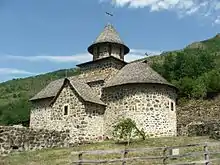Raška architectural school
Raška architectural school (Serbian: Рашка школа архитeктуре), also known as the Raška style (Рашки стил, Raški stil), or simply as the Raška school, is an ecclesiastical architectural style that flourished in the Serbian High Middle Ages (ca. 1170–1300), during the reign of the Nemanjić dynasty. The style is present in the notable Morača Monastery, Uvac monastery and Dobrilovina monastery, among many others. This style combines traditional Slavic architecture with early Christian church-design, and often utilizes a combination of stone and wood material.
Raška has the only extant significant, historical monument from the time of the acceptance of Christianity -- Church of the Holy Apostles Peter and Paul, Ras -- in Novi Pazar. Meanwhile, the other state, Zeta, had characteristics of the early Romanesque period, Latin in style.
Towards the end of the 12th century, however, Stefan Nemanja united Raška and Duklja. When his young son Sava founded the independent church in 1219, all these cultural bridges connected Serbia to the best-known centers of world art, Salonika and Constantinople one the one side and Venice and the Adriatic coast on the other.
Examples
- Rmanj Monastery, built by Katarina Branković, daughter of Serbian despot Đurađ Branković in 1443.
- Uvac Monastery, built by the Nemanjic dynasty in the 13th century
- Gomionica monastery, built in the 15th century
- Kumanica monastery, built in the 15th century
- Mala Remeta Monastery, built by King Dragutin in the 13th century.
- Dobrilovina Monastery, built before the 16th century
- Monastery Moštanica, built by King Dragutin in the 13th century
- Morača Monastery, built by Stefan Vukanović in 1252
 Rmanj, built in 1443
Rmanj, built in 1443 Monastery Uvac
Monastery Uvac Gomionica
Gomionica.JPG.webp) Dobrilovina
Dobrilovina Monastery Moštanica is located near Kozarska Dubica
Monastery Moštanica is located near Kozarska Dubica Kumanica
Kumanica Mala Remeta
Mala Remeta Monastery Moraca built in 1252 by Stefan Vukanović Nemanjić
Monastery Moraca built in 1252 by Stefan Vukanović Nemanjić
References
Sources
- Народни музеј у Београду (2015). "Рашка школа архитeктуре". Догађања. National Museum of Serbia.
- Sir Banister Fletcher; Dan Cruickshank (1996). Sir Banister Fletcher's a History of Architecture. Architectural Press. pp. 322–. ISBN 978-0-7506-2267-7.
_-_by_Pudelek..jpg.webp)